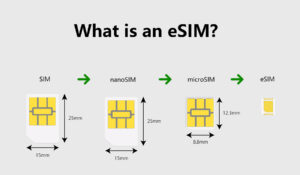eSIM ni nini? – What is eSIM?
Job Overview

eSIM ni nini? – What is eSIM?
eSIM ni nini? – What is eSIM?
Wondering what is an eSIM? Well, eSIM, or embedded Subscriber Identity Module, is a transform technology that is redefining the way we connect to mobile networks. Unlike traditional physical SIM cards, eSIMs are integrated directly into devices, eliminating the need for a physical card swap. This innovation offers a range of benefits and considerations that are reshaping our digital communication landscape.
An eSIM is a digital version of the physical SIM card – virtually to provide network connection. eSIMs also offer the same advantages as dual-SIM phones with two slots for traditional plastic SIMs. If your phone supports eSIM technology, you can download an eSIM data plan, install it on your device, and instantly connect to a mobile network.
What’s the difference between SIM and eSIM?
eSIMs are designed to supersede old-style physical SIMs (and, in case you’re wondering, the ‘e’ stands for embedded). Instead a removable plastic card inside your phone, an eSIM is a small chip embedded in your handset.
Do all smartphones have an eSIM?
All major smartphone manufacturers brands such as Apple, Samsung, Google pixel and Microsoft offer eSIM devices.
Is eSIM Better? Advantages and Disadvantages
So now you know what is eSIM. eSIM has sparked a significant shift in how we approach mobile connectivity, leaving us pondering a pivotal question: Is eSIM truly better? To answer this query, we will delve into the pros and cons of using this eSIM card:
Pros of eSIM:
- Unmatched Convenience: eSIM enables hassle-free activation and switching between carriers without the need for a physical SIM card.
- Space-Efficiency: Devices with eSIM technology have more internal space for other components, contributing to sleeker designs and enhanced functionality.
- Multiple Profiles: eSIM supports the storage of multiple carrier profiles on a single device, catering to travelers and multi-plan users.
- Remote Activation: eSIMs can be remotely activated, making it a breeze to switch carriers or add plans while on the go.
- Environmental Impact: With reduced plastic waste and manufacturing materials, eSIM is environmentally friendly.
Cons of eSIM:
- Device Compatibility: Not all devices support eSIM technology, limiting its availability.
- Carrier Dependency: eSIM activation and compatibility depend on carrier support and device manufacturers.
- Security Considerations: Remote activation might introduce security risks if not properly managed
- Changing Carriers: Some carriers may not yet offer eSIM support or may have limitations on their usage.
- Backup Challenges: Unlike physical SIM cards, eSIMs cannot serve as a backup in case of device loss or malfunction.
How Does eSIM Work?
At its core, eSIM functions much like its physical counterpart, storing essential information required for network access. However, eSIM takes this a step further by allowing you to remotely provision and manage your network profiles. Activation is often initiated through a QR code, app, or carrier-enabled process, eliminating the need for manual card insertion.
Behind the scenes, as how eSIM works, it relies on a secure chipset within your device, ensuring that your network data remains safe. The convenience doesn’t end there – eSIMs enable seamless switching between carrier profiles without any physical intervention, making it ideal for travelers or those seeking flexible connectivity options.
- Total Jobs 332 Jobs
- Category Nafasi za Ajira
- Location Tanzania


